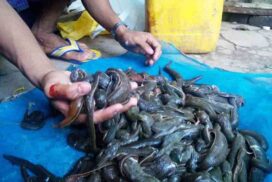As an agricultural country, Myanmar has many good bases for cultivating many kinds of agricultural products.
Among the agricultural products, tapioca can be successfully cultivated and is a potential export product if properly cultivated, according to international reports.
International Centre for Tropical Agriculture-CIAT is also providing technical assistance to local farmers in less-developed Southeast Asian countries to help them grow tapioca for the rapid economic development. The local farmers from Viet Nam, Thailand, Laos, Cambodia and Indonesia are earning extra income by growing tapioca.
The residents from Kyonpyaw, Hinthada, Lemyethna and Yekyi townships in Ayeyawady Region grow about 30,000 acres of tapioca yearly in their region. Then, the tapioca is made the powder through companies’ traders and it became a local product. Each tapioca acre can produce about 3,000-3,500 visses.
In 2014, the Ayeyawady Region Tapioca Growers and Exporters Association was formed to improve tapioca production, led by the consumer affairs department. Then, the association conducted the workshop and invited the international experts led by Dr Robert Anderson Cranb from Queensland university to provide awareness to the local farmers in 2015. Besides, the association attended 4th starch world, held in Inya Lake Hotel, Yangon and sent study tours to Thailand and China.
Under the cooperation plan of the tapioca industry development, the association distributed the Hauy Bong-60 high yielding tapioca species to the local farmers. Hauy Bong-60 species have yielded about 7,500-10,000 visses per acre.
China buys about 11.5 million tonnes of tapioca powder yearly.
In the near future, with the rising price of other industrial raw crops such as corn, tapioca, a potential alternative, it will inevitably become a local product of the Ayeyawady Region, which has a very high demand for its products. — District IPRD/GNLM
Tapioca successfully cultivated in Ayeyawady region for potential export item
- February 24, 2022
- 1763














